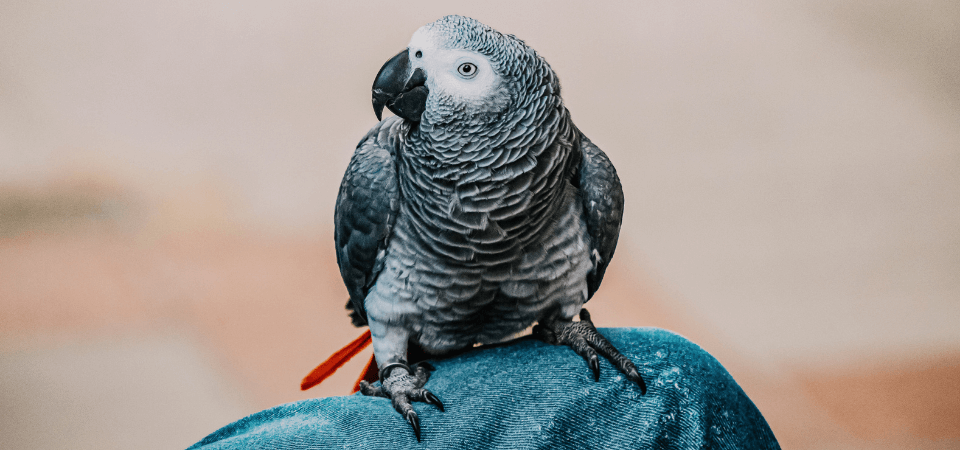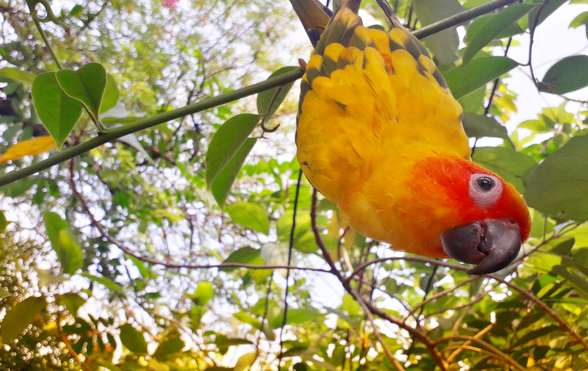Vet expert Dr. Sophie Bell discusses the issue of Aspergillosis in Parrots. She explores causes, the most common symptoms, the main preventative methods, how it is diagnosed and then treated and prevented.
Is your parrot insured? Get a quote for £5,000 of vet fee cover | Insure up to 3 pets per policy | We’ve been insuring exotic pets since 1996 | Check out our customer reviews on Feefo.
What is Aspergillosis
The fungus known as Aspergillus is found in mouldy food, soil, dust and damp nesting material. The spores are microscopic and despite rigorous cleaning, are hard to eradicate.
Their presence puts your bird at risk of the disease Aspergillosis.
Aspergillosis can cause a range of respiratory symptoms affecting the upper respiratory tract (eyes, sinuses, nose and trachea), lower respiratory tract (lungs and air sacs) and the whole bird, leading to systemic disease.
Aspergillosis is not contagious, if you keep more than one parrot, those affected with Aspergillosis will not be a risk to the other birds.
Parrots with a strong healthy immune system may tolerate Aspergillus spores and not go on to develop disease.
However a large volume of spores can also affect healthy birds, with high risk of them also becoming unwell.
The disease is not zoonotic, so you are not at risk from an infected parrot.

Aspergillosis and Parrots
Symptoms associated with Aspergillosis
- Looking fluffed
- Lethargy and depression
- Weight loss
- Respiratory difficulties/distress
- Exercise intolerance
- Tail bobbing
- Enlarged nostrils +/- discharge
- Inappetence
- Excessive thirst known as polydipsia
- Excessive urination known as polyuria
- Vocalisation or reluctance to talk if the voice box is affected. A click may be heard
- Open beak breathing
- Cyanosis – grey-blue colour to skin
- Green urates – if the liver is affected
- Tremors
- Loss of coordination
- Paralysis
Aspergillosis can affect the upper respiratory tract which can lead to ocular changes such as a dull or cloudy appearance to the cornea, photophobia which is a sensitivity to light, blepharospasm which is an involuntary spasm of the eye lids, and discharge.
Depending on the severity of the disease and its spread, symptoms will be variable and spread to the lower respiratory tract which will ultimately lead to respiratory distress.
Chronic or Acute Aspergillosis?
Chronic Aspergillosis
Chronic Aspergillosis usually affects older birds and is more common than acute aspergillosis.
Symptoms can be vague at the beginning, any bird who is listless and seems weak should be seen by a vet.
Usually, respiratory difficulties are seen once the disease has worsened which is often when there is permanent damage to the lungs.
White nodules form on the lung tissue and these often erode. This allows the disease to spread to other organs as the spores enter the bloodstream. It can also affect the central nervous system, leading to symptoms such as tremors and paralysis.
Prognosis for these birds is poor, as the condition is in an advanced state.
Acute Aspergillosis
Acute aspergillosis usually affects younger birds, the disease progression is much faster with breathing difficulties and other associated symptoms developing rapidly.
If left untreated or not treated quickly enough, the bird is likely to die and sadly most birds are diagnosed via a post-mortem examination.
The air sacs, a part of the respiratory tract in birds, can become inflamed. This is known as airsacculitis. Or inflammation of the airsacs. They become congested with a white mucus. Causing further respiratory distress for the bird.
Although acute it may allow for a better prognosis, although sometimes it can be so acute it’s fatal.
It’s very dependent on the parrot’s overall immunity if they were strong and healthy prior to the infection, their survival rate improves. Certainly prompt treatment will lead to a better prognosis.
How can you minimise the risk of Aspergillosis?
- Hygiene and excellent husbandry are important in minimising the risk.
Remove any old food regularly and ensure a good well-balanced diet. Nutrition is especially important for the prevention of disease. Birds fed mainly on seed can be at an increased risk as seed lacks vitamin A, an important vitamin for respiratory health and a good immune system.
2. Use safe cleaning products that do not contain alcohol, aldehydes and phenols.
Make sure they are non-toxic and non-irritant and clean regularly including toys and feeding vessels, remove all faecal matter and mould.
3. Ensure your bird has plenty of mental stimulation and a space to exercise.
Stress can play a major role in disease development and boredom can make your parrot feel frustrated and stressed.
4. Avoid using any respiratory irritants around your bird
Avoid cigarette smoke, strong cleaning products, scented candles, open fires, aerosol sprays and incense burners. These can lead to permanent damage to the lungs and air-sacs over time. Always ensure good ventilation for your bird.
If your bird is on long-term antibiotics and/or steroids it is important to be aware that their immune system is likely to be weaker. Using species specific probiotics daily can help boost your parrot’s immune system and are a great addition to any parrot’s daily routine.
Any bird suffering with another chronic or acute disease can be prone to developing secondary aspergillosis. Once again this will be due to a weakened immune system.
How is Aspergillosis diagnosed?
Multiple tests are often required to reach a diagnosis of aspergillosis, often a complete blood count is the first test performed.
Raised white cells would be suggestive of infection and/or inflammation and coupled with clinical signs may lead to suspicions of aspergillosis.
X-rays in the late stages are more reliable showing pneumonia, airsacculitis and bone breakdown. But in the early stages, x-ray findings are often subtle and not necessarily diagnostic.
Antibody tests can be misleading firstly because they can produce a false negative result and secondly because healthy birds can carry aspergillosis without clinical signs. It may not be the underlying cause of your sick bird at this stage.
A tracheal wash can be performed, but again healthy birds can carry the spores with no disease. DNA tests can be used to look for Aspergillosis in tissues and blood.
Laparoscopy is the most accurate method of diagnosis, where an endoscope is passed into the bird’s airways and samples are collected for culture and analysis.
This last method will require a general anaesthetic. A CT scan can also provide useful imaging to aide diagnosis.
What is the treatment for Aspergillosis?
This fungus is notoriously hard to treat and difficult to cure. Anti-fungal medications most commonly itraconazole (not tolerated well by Grey parrots) or voriconazole (which appears to be more effective) are often used.
Treatment may be given orally, inhaled, topically and/or intravenously. If a bird has a weakened immune system, complete elimination can be exceedingly difficult.
Sometimes surgery is required to remove the fungal plaques. It is important to treat any other underlying disease and provide supportive care throughout treatment.
This may include oxygen therapy, assisted feeding, supplementation of vitamin A to help repair the air-sac lining, and anti-inflammatory medications.
For birds with severe breathing difficulties, an air-sac breathing tube may need to be surgically placed. Intravenous fluids may be given to support the liver and kidneys and can play a role in removing the fungal toxins.
It is important to keep the environment well ventilated and warm and alter the diet and overall living conditions accordingly.
Is your parrot insured? Get a quote for £5,000 of vet fee cover | Insure up to 3 pets per policy | We’ve been insuring exotic pets since 1996 | Check out our customer reviews on Feefo.
Own a cat or dog? Get pet insurance that covers up to £12,000 for dogs and £9,000 for cats in vet fees every year, including dental for illness and accidents with British Pet Insurance.

